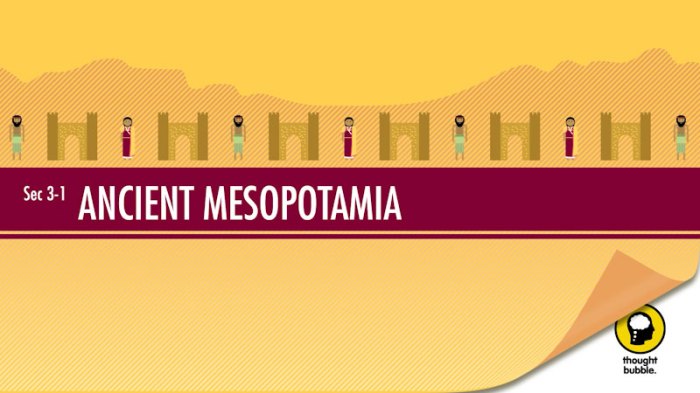Crash course world history mesopotamia – Embark on an enlightening journey through the annals of history with Crash Course World History: Mesopotamia, the Cradle of Civilization. This comprehensive exploration unveils the captivating narrative of one of the world’s earliest and most influential civilizations, where the foundations of human progress were laid.
From the dawn of Sumerian city-states to the grandeur of the Babylonian Empire, Mesopotamia’s legacy continues to resonate, shaping the course of human civilization. Join us as we delve into the rich tapestry of this ancient land, uncovering its profound impact on our present-day world.
Mesopotamia: A Cradle of Civilization

Mesopotamia, the “land between the rivers,” was one of the earliest cradles of civilization, emerging in the fertile region between the Tigris and Euphrates rivers. Its geographic location and abundant resources played a crucial role in its development.
Geographic Location and Environmental Factors
Mesopotamia’s strategic location at the crossroads of major trade routes fostered cultural exchange and economic growth. The fertile alluvial soil, deposited by the rivers, provided ideal conditions for agriculture, supporting a growing population.
The Rise of Sumerian City-States
Around 3500 BCE, the Sumerians established the first city-states in Mesopotamia. These city-states, such as Ur, Uruk, and Lagash, were independent political and economic entities.
Political and Social Structures
Sumerian city-states were ruled by kings or priests who held absolute power. Society was divided into social classes, with the elite at the top and slaves at the bottom. Each city-state had its own patron god and a complex system of religious beliefs.
Trade and Agriculture
The Sumerians were skilled traders and merchants. They traded with distant lands, exchanging goods such as grain, textiles, and metalwork. Agriculture was the backbone of their economy, with farmers cultivating crops like wheat, barley, and dates.
The Akkadian Empire
In the 23rd century BCE, Sargon of Akkad conquered the Sumerian city-states and established the first empire in Mesopotamia.
Contributions of Sargon of Akkad
Sargon was a brilliant military strategist who expanded the Akkadian Empire from the Persian Gulf to Anatolia. He introduced a centralized administration and standardized weights and measures.
Expansion and Collapse
The Akkadian Empire reached its peak under Sargon’s grandson, Naram-Sin. However, internal conflicts and invasions from nomadic tribes led to its eventual collapse.
The Babylonian Civilization
After the fall of the Akkadian Empire, the city of Babylon rose to prominence. The Babylonian civilization flourished for centuries, making significant cultural and intellectual advancements.
Cultural, Intellectual, and Technological Advancements
The Babylonians developed a sophisticated system of writing, cuneiform, and made advancements in astronomy, mathematics, and medicine. They built monumental structures, including the Ishtar Gate and the Hanging Gardens of Babylon.
Contributions of Hammurabi and the Code of Hammurabi
King Hammurabi is renowned for his famous Code of Hammurabi, one of the earliest known written legal codes. The code established a system of justice based on the principle of “an eye for an eye.”
The Assyrian Empire

The Assyrians emerged as a powerful empire in the 9th century BCE. Known for their military prowess and brutality, they established one of the largest empires in ancient history.
Military Prowess and Territorial Expansion
The Assyrians were highly skilled in warfare and employed advanced siege techniques. They conquered vast territories, stretching from Egypt to Persia.
Methods of Maintaining Control
The Assyrians maintained control over their vast empire through a system of provincial governors, forced deportations, and brutal punishments.
The Neo-Babylonian Empire: Crash Course World History Mesopotamia

After the fall of the Assyrian Empire, the city of Babylon once again rose to power under the Neo-Babylonian Empire.
Rise and Fall
Nebuchadnezzar II, the most famous ruler of the Neo-Babylonian Empire, conquered Jerusalem and destroyed the First Temple. The empire eventually fell to the Persian Empire in 539 BCE.
Cultural and Architectural Achievements, Crash course world history mesopotamia
The Neo-Babylonians were renowned for their cultural and architectural achievements. They rebuilt the city of Babylon and constructed the Ishtar Gate, one of the most iconic structures of the ancient world.
The Persian Empire

The Persian Empire, founded by Cyrus the Great, was the largest and most powerful empire in the ancient world.
Size, Diversity, and Administrative Structure
The Persian Empire stretched from the Indus River to the Mediterranean Sea. It was incredibly diverse, encompassing a wide range of cultures and languages. The empire was governed by a centralized bureaucracy.
Factors Contributing to Success and Longevity
The success and longevity of the Persian Empire can be attributed to its efficient administrative system, its tolerance of diverse cultures, and its advanced military.
Mesopotamia’s Legacy
Mesopotamia’s civilization left an enduring legacy on subsequent cultures. Its contributions to writing, mathematics, law, and astronomy have had a profound impact on the development of human civilization.
FAQ Resource
What were the key characteristics of Sumerian city-states?
Sumerian city-states were independent political entities characterized by their walled cities, complex social structures, and thriving economies based on trade and agriculture.
How did the Akkadian Empire contribute to Mesopotamian history?
The Akkadian Empire, founded by Sargon of Akkad, established the first centralized state in Mesopotamia, expanding its influence through military conquest and promoting cultural exchange.
What is the significance of the Code of Hammurabi?
The Code of Hammurabi, enacted by King Hammurabi of Babylon, is one of the earliest known written legal codes, providing insights into the social and legal practices of ancient Mesopotamia.
How did the Assyrian Empire maintain control over its vast territory?
The Assyrian Empire employed a formidable military, advanced administrative systems, and strategic alliances to maintain control over its extensive empire, extending from present-day Turkey to Egypt.
What were the major achievements of the Persian Empire?
The Persian Empire, founded by Cyrus the Great, was renowned for its size, diversity, and administrative efficiency, promoting cultural exchange and infrastructure development across its vast territories.
